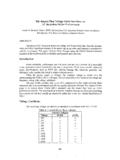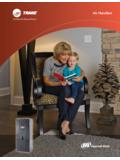Transcription of Two-Stage High Efficiency Air Conditioners: …
1 Two-Stage high Efficiency Air conditioners : laboratory Ratings vs. Residential Installation Performance John Proctor and Gabriel Cohn, Proctor Engineering Group, Ltd. ABSTRACT The increased installation of high Seasonal Energy Efficiency Ratio (SEER) air conditioners along with utility program rebates for these units prompted a study of the measured performance of these systems. This project assessed the performance of these systems in the climate zones found in the mid-Atlantic region of the Similar studies in hot dry climates have indicated that laboratory SEER ratings may not properly predict the actual impact of these systems. This project monitored four high SEER air conditioners with dual- stage compressors, TXV metering devices, and high Efficiency air handlers with ECM fan motors.
2 One system with a single- stage compressor was also monitored. Data included capacity, power consumption, Energy Efficiency Ratio (EER), indoor/outdoor temperature and relative humidity. The data were analyzed to assess the relationship between laboratory testing and real world performance. This study found causes for concern including: actual seasonal energy Efficiency ratios between 59% and 84% of the rated SEERs, constant fan operation substantially degrading seasonal efficiencies and reducing dehumidification, latent loads that exceed Manual J estimates, and sensible loads substantially lower than Manual J estimates. In addition there may be an energy and peak load penalty if dual- stage air conditioners are downsized to near the buildings actual loads. The study illustrates the intricacy of the whole building system.
3 The air conditioners in the two leakiest building shells were unable to adequately control the indoor humidity. Introduction Utilities and contractors across the United States have successfully promoted the installation of high SEER central air conditioning systems. high SEER systems are often equipped with dual- stage compressors and variable speed blowers. This study addressed the impact of these systems on the electric grid in Department of Energy (DOE) Climate Zones 4 and 5. The test houses were located in New Jersey and New York at the Northern edge of Climate Zone 4 and the Southern edge of Climate Zone 5. Both climate zones are considered moist , where outdoor air often contributes to the latent load on the air conditioner. A continuing question in the energy- Efficiency community is how closely SEER ratings represent the actual seasonal Efficiency of air conditioners in various climates.
4 Given the increasing frequency of these installations and emphasis of utility programs on installing higher Efficiency SEER equipment, it is important to quantify the impact of these high Efficiency systems. The purpose of this study was to compare the operating characteristics (peak demand, EER, and kWh) of high Efficiency residential central air conditioning systems to projections from ratings including SEER and EER. 1-223 2006 ACEEE Summer Study on Energy Efficiency in BuildingsOne of the objectives of this study was to compare dual- stage units against a high Efficiency single speed unit. This study monitored four recently installed dual- stage air conditioners and one high Efficiency single speed AC system. Monitoring System Each air conditioner was monitored by a data acquisition system (DAS).
5 The DAS has the flexibility to perform many data acquisition functions and is capable of being downloaded or reprogrammed via modem. The temperature probes were bare wire 36 gauge type T thermocouples, RTDs, or thermistors. Condensate flow from the indoor coil was measured with the use of a tipping bucket gauge attached to the termination of the condensate drain. Data points are summarized in Table 1. Table 1. Monitored Points Measurement Sensor Type Sensor Location Supply Air Dry Bulb Temperature 4 Point RTD Grid After Coil In Supply Plenum Supply Air Dry Bulb Temperature Thermister After Coil In Supply Plenum Supply Air Dry Bulb Temperature Thermocouple After Coil In Supply Plenum Supply Air Dry Bulb Temperature Thermocouple Far Supply Register Supply Air Dry Bulb Temperature Thermocouple Near Supply Register Supply Air Relative Humidity Humidity Transmitter With Supply Air Thermister Return Air Dry Bulb Temperature Thermister Return Plenum Before Furnace Return Air Dry Bulb Temperature Thermocouple Return Plenum Before Furnace Return Air Dry Bulb Temperature Thermocouple Return Grill Return Air Relative Humidity Humidity Transmitter With Return Air Thermister Buffer Space Dry Bulb Temperature Thermocouple
6 Buffer Space Outside Air Temperature Thermister (Shielded) Outside Near Condensing Unit Outside Air Relative Humidity Humidity Transmitter With Outside Air Thermister Indoor Air Temp Thermister Near Thermostat Compressor Discharge Temperature RTD Surface Mounted To Compressor Gas Discharge Line (Insulated) Refrigerant Liquid Line Temperature RTD Surface Mounted To Liquid Line After Condenser Coil (Insulated) Condenser Saturation Temperature 2 Thermocouples Surface Mounted to Condenser Refrigerant Circuit Evaporator Saturation Temperature 2 Thermocouples Surface Mounted to Evaporator Refrigerant Circuit Vapor Suction Line Temperature RTD Surface Mounted To Suction Line Before Compressor (Insulated) Evaporator Condensate Flow Tipping Bucket Evaporator Condensate Line Compressor Current Current Transducer Compressor Power lines Furnace Blower Current Current Transducer Blower Power Lines Furnace Gas Valve Current Current Transducer Gas Valve Control Lines Condensing Unit Power Watt Transducer Electrical Supply To Unit Furnace Blower Power Watt Transducer Electrical Supply To Furnace Unit Site Descriptions The characteristics of the homes and air conditioners in the project convenience sample are listed in Table 2.
7 1-224 2006 ACEEE Summer Study on Energy Efficiency in BuildingsTable 2. Site Characteristics House Specifications Site P1 Site S Site T Site N Site W House Size (square feet) 1620 2375 1900 3500 2300 Year Built 2002 2000 1940s 1960s 1970s Manual J7 Cooling Load (Btuh) at 90/75/63 no window coverings 22118 36342 27513 56462 29549 Manual J7 Cooling Load (Btuh) at 90/75/63 with drapes 18180 29471 22851 44106 23864 House Tightness: Air Changes per Hour (ACH50) Air to Air Heat Exchanger Flow (% of airflow) 17% 12% none none none % of Time Indoor RH >60% 2% 13% 0% 40% 35% Air Conditioner Specifications Rated SEER 14 15 14 14 high Speed Rated EER at 95/80/67 Low Speed Rated EER at 95/80/67 None high Speed Rated Capacity at 95/80/67 (Btuh) 34900 46080 34300 48230 48230 Low Speed Rated Capacity at 95/80/67 (Btuh)
8 None 25260 24700 27180 27180 Number of Compressor Speeds 1 2 2 2 2 Metering Device Fixed TXV TXV TXV TXV Fan Motor Hp 1/2 Hp 1 Hp 1 Hp 1 Hp 1 Hp Fan Motor Type ECM ECM ECM ECM ECM Fan Mode (TD = Time Delay IO = Instant Off) TD Const. TD IO Const. 1. ARI ratings are not available for the Site P system combination (using a third party evaporator coil). The estimated rated SEER, EER, power, and capacities are for a manufacturer s combination with the same nominal capacity. House Characteristics All the sites were two-story homes with furnaces and ducts in the basement. Site P is a new modular home and Site S is a new ENERGY STAR home. The homes were tested for air leakage using a single point (50 Pascals) blower door test. There was a large variation in the measured air leakage ( ACH50 to ACH50).
9 Sites N and W were the leakiest homes and the dual- stage /variable airflow air conditioners were unable to adequately control the inside relative humidity. The cooling loads were calculated using Manual J7 at an inside/outside temperature difference of 15 F, with an infiltration rate estimated from the blower door test, with latent and sensible loads calculated independently, with the swing factor set to 1, and with no window coverings. Site N has a Manual J 7 estimated load that exceeds the nominal tonnage of the installed air conditioner an unusual situation. Aggressive Manual J7 load estimates were also calculated based on interior drapes on all the windows. Air Conditioner Specifications The air conditioners represented a narrow band of efficiencies from 14 to 15.
10 The units were three-ton and four-ton units. There were three different types of furnace fan operation observed in these units: Constant on this produces the minimum latent capacity since moisture on the coil at the end of the compressor cycle is evaporated back into the house air; Time delay 1-225 2006 ACEEE Summer Study on Energy Efficiency in Buildingsthis is the most common fan control which is designed to maximize the SEER of the unit; and Instant off the fan control which should produce the most latent cooling (moisture removal). Two homes used a constant fan. One home used the constant fan to circulate air around musical instruments, pianos, cellos, etc. The other home began using a constant fan part-way through the summer for an unknown reason. Results Cooling Season results are tabulated by 5 F temperature bins and compared to the manufacturer s ratings.













